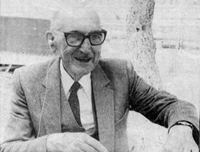New edition of the Atlas of endangered languages
Paris, 9 February

- © John-Thor Dahlburg
- Tevfik Esenç : He was the last person able to speak the language they called Ubykh
Why do languages disappear? Which parts of the world are most affected? What can be done to save them? The new edition of the UNESCO Atlas of the World's Languages in Danger of Disappearing aims to answer these questions. It will be presented to the press at UNESCO Headquarters on 19 February, on the eve of International Mother Language Day (21 February).
The Atlas is published for the first time as an interactive, digital tool with updated information on over 2500 languages.* The fruit of a collaborative effort by a team of linguists under the direction of Australian linguist Christopher Moseley, the Atlas is available free of charge worldwide. It will be continually updated and will allow users to produce their own maps, based on a country or region, or to conduct searches by language category – extinct, critically endangered, severely endangered, definitively endangered. Production of the Atlas has been made possible thanks to a donation from Norway.
The day after the launch, on 20 February, UNESCO Headquarters will host celebrations for International Mother Language Day. The Director-General of UNESCO, Koïchiro Matsuura, will open the celebrations (10 a.m., Room IV). Other participants at the opening session will include: Olabiyi Babalola Yaï, President of UNESCO’s Executive Board; Mohammed Kabir, Ambassador of Bangladesh to France and Permanent Delegate to UNESCO; and Adama Samassékou, interim Executive Secretary of the African Academy of Languages (ACALAN).
The Atlas will then be presented to the public, followed by a review of activities carried out during the International Year of Languages (2008). In the afternoon, (3 p.m. to 5 p.m., Room IV), a roundtable discussion will be held, entitled The question of languages for communities: the way forward, with Françoise Rivière, UNESCO’s Assistant Director-General for Culture, Martin Benjamin, Director of the Kamusi Project, Andrew Ikupu, of the National Department of Education of Papua New Guinea, Gloria Cáceres, Professor of Quetchua at the Peruvian School of Languages, Mathura Tripura, Executive Director of the NGO, Zabarang Kalyan Samity (Bangladesh), Ahmed Boukouss, Rector of the Royal Institute of Amazigh Culture (Morocco), Akinwumi Isola, of the Department of Linguistics and African Languages at the University of Ibadan (Nigeria).
At 5.30 p.m. the Design 21 prize will be awarded to the designer of the winning poster for International Mother Language Day. It will be followed by a screening of The Linguists, in the presence of its director and producer, Daniel Miller. International Mother Language Day celebrations will also include exhibitions by the painters, Monica Jahan Bose and Imtiaj Shohag.
* A paper version of the Atlas will be published in the coming months in English, French and Spanish.
The Atlas will be presented at a press conference (11 a.m., Room IX) in the presence of Françoise Rivière, Christopher Moseley and Marleen Haboud.
- Author(s):Media Advisory N°2009-06
- Source:UNESCOPRESS
- 09-02-2009

